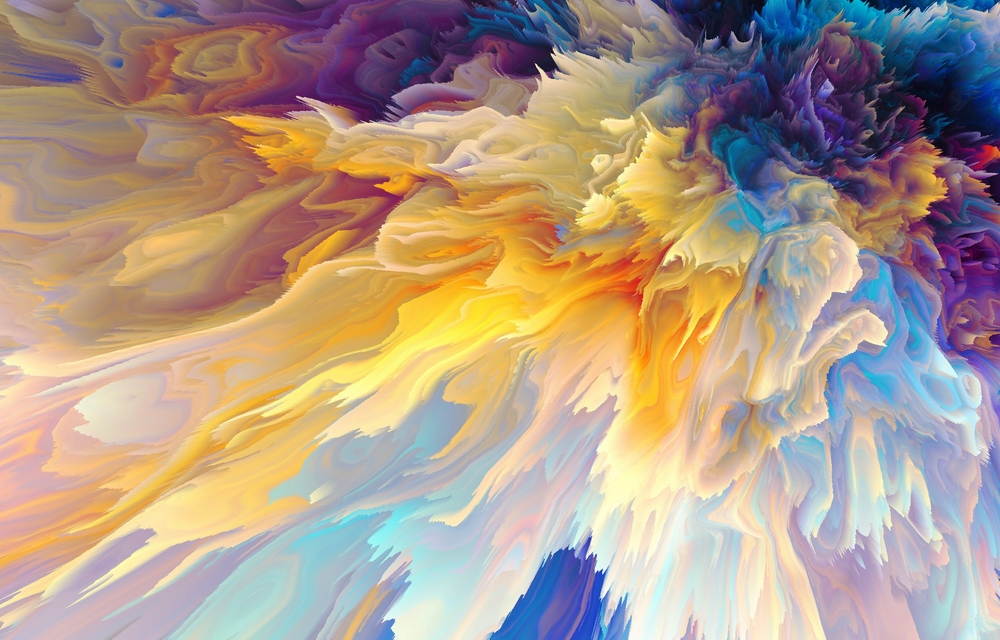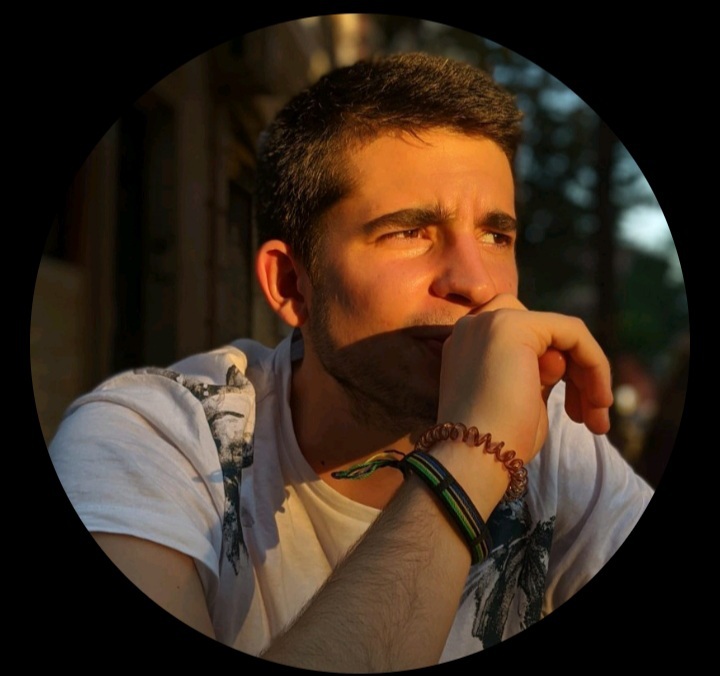Discover what is fractal art and learn how artists create works in this space in our guide.
Fractal Art is a relatively new form of abstract art composed of geometric patterns generated with the aid of algorithms and specialized computer programs.
Although you might assume that computer-generated art would lack the originality that makes traditional art so alluring fractal art has an almost hypnotic structure that is becoming increasingly popular with artists and art collectors.
This guide will explore how fractal art is created, the top fractal art creators, and how you can make your own fractal art using open-source software.
Table of Contents
What is Fractal Art?
Fractal art is where maths meets creativity and generates stunning digital art pieces with the help of fractal-generating software. The computer-generated fractal images are self-similar geometric shapes that have never-ending patterns.
Mathematical equations generate the fractal patterns and then splice them into multiple shapes that reproduce an infinite number of times.
Even though fractal designs can at first appear chaotic, in nature, their symmetry is perfect. You’ve almost certainly come across 3D fractal art before, maybe on your computer’s screensaver or in snowflakes, feathers, seashells, and coastlines.
Mandelbrot Coins The Term Fractal
Arguably fractal geometry has been around since the universe exploded into existence, as we can find countless examples of it in the natural world.
However, computer-generated fractal images and animations are a late 20th-century art form. If you’ve got an interest in the NFT space, you might think fractal art is the same as generative art; it isn’t, and if you want to avoid mixing them up, check out our generative art guide.
In 1975 the mathematician Benoit Mandelbrot coined the term’ fractal’ while researching natural geometric shapes.
Benoit published his book “Fractals: Forms, Chance and Dimensions” in 1977, explaining that fractal forms could be created by breaking smooth shapes into smaller pieces and then molded together in a process called iteration, which leads to the endless repetition of the patterns.
Benoit Mandelbrot found that you can zoom in on fractal patterns and the smaller images have the same structure as the overall pattern.
The Mandelbrot Set and Julia Set
The mathematic equation behind the pattern is (zn+1 = zn2 + c), and this is known as the Mandelbrot Set. This equation is used to sample complex numbers that, when expressed as still images and animations, create visually appealing patterns with repeating details.
The Julia Set is a fractal pattern that was named after the mathematician Gaston Julia and expresses a complex and highly dynamic fractal pattern that’s related to the Mandelbrot Set.
Julia and Mandelbrot’s sets are the leading fractal equations, and they use variations of the same method to create different fractal patterns.
The Impact Of Fractal Patterns
Mandelbrot’s discovery impacted far more than just the digital art world; it turns out the fractal patterns had implications for a whole range of scientific fields, including the design of internet networks, systems that compress computer files, and even the analysis of financial markets.
Digital artists, computer scientists, and mathematicians have taken the Mandelbrot set and created inspiring fractal art projects.
Top 5 Fractal Artists
The most well-known Fractal art creators are generally specialists who have committed their careers to create computer-generated fractal patterns and animations.
However, the first name on our list, Jackson Pollock, is someone you probably didn’t expect to be reading about in this article, even though you’d be hard-pressed to find someone who hasn’t marveled at his work
1. Jackson Pollock
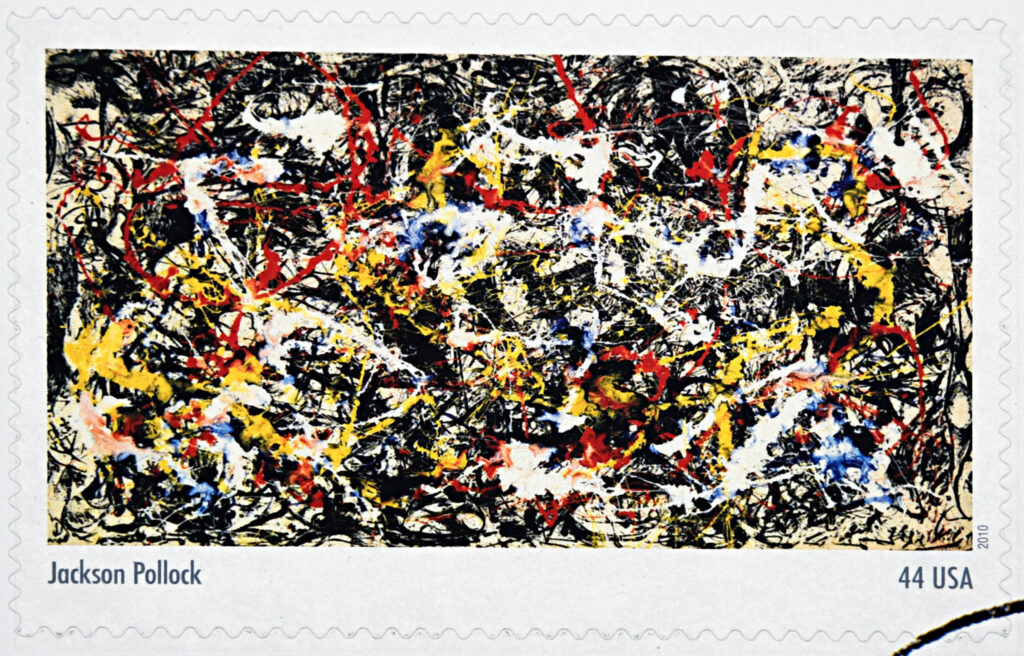
Jackson Pollock is famous for his leading role in the expressionism art movement; specifically, people have long admired his drip paintings displayed in top-tier art galleries worldwide.
Although Pollock would have had no idea of what fractal was as a mathematic concept, it’s recently been revealed that his drip paintings incorporate fractal swirls and patterns.
The abstract expressionism of Pollock is actually littered with fractal geometry, and if you take the time to magnify some of his work, you’ll see the self-similar patterns indefinitely spiraling across the canvas.
It appears that Pollock set out to create chaotic art through splashes of paint, but within the anarchy, the mathematic nature of fractals created indefinite order.
2. Carlos Ginzburg
Carlos Ginzburg is an Argentinian conceptual artist who has dedicated much of his work to digital art and the use of fractal patterns.
Ginzburg is best known for his piece titled ‘homo fractalus’; this mismatch of fractal patterns and images was designed to express the complex nature of humanity as a single fractal image.
Ginzburg has had his fractal work displayed in some of the world’s most prestigious galleries, such as the Museo Nacional Reina Sofia, Madrid, Spain, and the Centre Georges Pompidou, Petit Forum, Paris, France.
3. Kerry Mitchell
Kerry Mitchell is a computer artist born in the United States who helped galvanize the fractal art field by publishing his Fractal Art Manifesto in 1999.
Mitchell codified the basic principles of Fractal Art in the manifesto that have since become widely accepted.
He outlined four things that Fractal Art is NOT:
- Computer Art: Although computer programs are critical to creating fractal art, the direction it takes is at the mercy of the artist, and without the artist’s input, the computer would not be able to create the fractal images or animations.
- Random: Despite the apparent chaos embedded in fractal art, strict mathematic rules are needed to render the images.
- Unpredictable: When Pollock was creating his ‘Drip‘‘paintings he may have felt that the patterns were the opposite of predictable, but when it comes to fractal art, there is a high element of pre-determination.
- Easy: Although programs to create fractal art are becoming increasingly user-friendly, just because you have a computer doesn’t mean anyone can create captivating fractal art without prior experience and creativity.
He then outlined four things that Fractal Art IS:
- Expressive: Fractal art is just as repressive of an artist’s emotions and thoughts as any other artistic field despite using algorithms.
- Creative: Fractal art begins as a blank canvas and develops into a piece of art through the artist’s creative input.
- Input: To create the art, a fractal artist must input formulas, color schemes, and mappings.
- Art: Beyond the nuances, fractal art is simply something created by a fractal artist, just like photographs, paintings, and music.
4. Scott Draves
Scott Draves is an American software artist who invented the fractal flames and developed the Electric Sheep computer art project.
Fractal flames are part of the iterated function systems (IFSs) that generate fractal patterns.
Beyond the beauty of the fractal flames, they’re a significant part of the fractal art world because they differ from the typical fractal patterns created by functions systems in the following ways:
- They are generated as both non-linear and linear, while other fractals are either one or the other.
- Their tone mapping and color create extremely detailed fractal patterns.
The Electric Sheep program is an open-source project that allows users to animate fractal flames into screensavers by rending fractal flame files into videos.
What makes the project so interesting is that the computers on the network communicate with each other and share the stunning fractal screensavers among the community.
5. William Latham
William Latham is a pioneer in Organic and computer Art and currently holds a position as a professor in the computing department at Goldsmiths University in London, England.
Latham is a leading figure in the fractal art world, and you can take a look at some of his work here.
One of this fractal artist’s most impressive pieces is titled ‘Colid Horn (Twist 5)’, which displays an intertwined series of infinite gold fractal loops against a dark background.
Latham’s computer art spans several fields, but he is best known for creating album covers for bands such as The Shamen.
The Best Fractal Art Software
If you’re a digital artist or just someone who is interested in computer art, you might want to try your virtual hand at creating fractal images.
Luckily, even if you aren’t familiar with coding, you can start creating stunning fractal objects with the help of tutorials and fractal-generating software.
The software programs carry out literation over three phases:
- Parameters: The computer program sets the correct parameters for the fractal piece.
- Maths: The algorithm calculates the incredibly complex process of creating indefinite self-similar patterns.
- Evaluate: The software checks the finished animation or image to ensure consistency.
We’ve prepared a list of the best software programs for you to consider using to kick-start your fractal art career.
1. Apophysis (MAC/Windows)
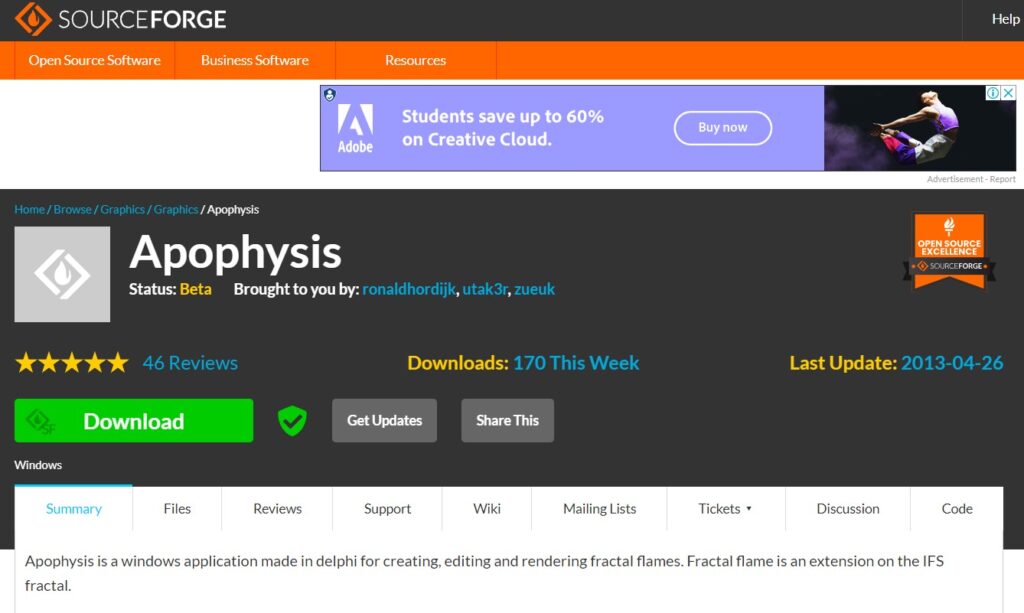
Apophysis is a fractal generator operated as an open-source platform where users can create, render and edit fractal flames.
The software uses a script language that allows you to manipulate the individual aspects of the fractal designs and alter their mapping and coloring.
The software also allows you to animate fractal flames in a similar way to Electric Sheep, which means it can be used to create screensavers and other moving designs.
2. Mandelbulb (Windows)
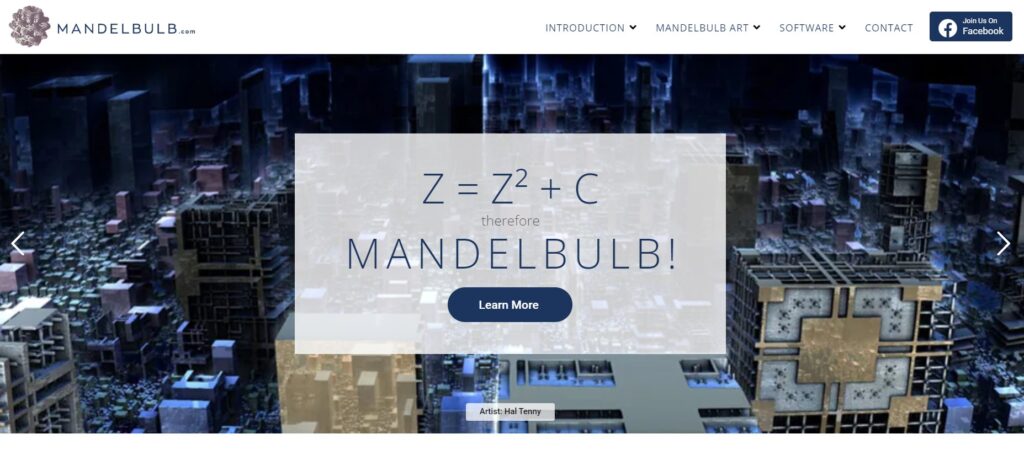
Mandelbulb is a 3D imaging software that is considerably more user-friendly than Apophysis. The rendering system allows you to add shadow effects and alter the depth-of-field and color.
Some very well-respected artists use the software in the industry, and you can check out their work here.
The power of the software is on full display through Jorge Abalo’s work; he uses fractal art in real-life settings and in psychedelic patterns.
3. FractalNow
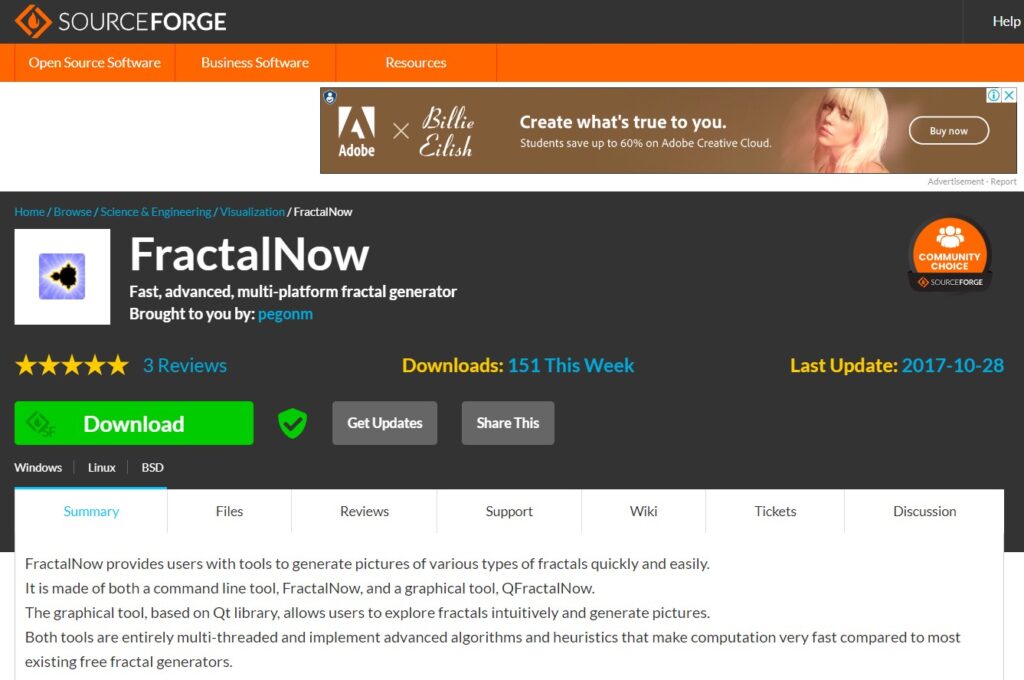
FractalNow is an open-source fractal rendering software specializing in creating still images. The platform provides you with the tools you need to create fractal art relatively quickly and easily.
Despite its relatively easy-to-use UI, the software employs advanced code to carry out detailed fractal generation.
You can check out some of the work created using FractalNow here.
Examples of NFT Fractal ART
Some NFT artists draw on this art for their creations. For example, consider Fractal Elements by visual effects artist Osipenkov.
Fractacious is a less-known NFT artist who use this art form for his creations too. He describes his work as “Sweet, Colorful, rich, bold, intense”
Artblocks regularly partners with artists who explore various art forms as part of their NFT creations. Although these Artblock collaborations are predominately generative art, their creations draw on elements of fractal art too, in that these creators use mathematical rules, and predetermined color schemes and adhere to strict parameters. One such example is Rotor by Sebastián Brocher (CryptoArte).
<nft-card contractAddress="0xa7d8d9ef8d8ce8992df33d8b8cf4aebabd5bd270" tokenId="315000083"> </nft-card> <script src="https://unpkg.com/embeddable-nfts/dist/nft-card.min.js"></script>
Arguably, the Eternal Pump by Dmitri Cherniak is another example of an NFT that contains elements of fractal art. He created this endlessly repeating pattern with Javascript and OpenGL Shading Language (GLSL).
<nft-card contractAddress="0xa7d8d9ef8d8ce8992df33d8b8cf4aebabd5bd270" tokenId="22000024"> </nft-card> <script src="https://unpkg.com/embeddable-nfts/dist/nft-card.min.js"></script>
Final Thoughts on Fractal Art
Fractal art is as fascinating as an artistic field and as a mathematical concept. Nature is littered with examples of fractal geometry that, thanks to Benoit Mandelbrot, we understand are products of a complex equation.
The development of personal computers and power algorithms has allowed artists to exploit fractal patterns using Mandelbrot’s research which has led to the creation of some wonderful collaborative pieces between man and machine.
We should expect the use of computers in the art world to grow as AI becomes increasingly capable of helping artists augment their creative prowess.

